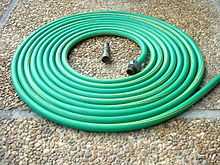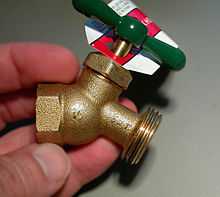Garden hose

A garden hose, hosepipe or simply hose is a flexible tube used to convey water. There are a number of common attachments available for the end of the hose, such as sprayers and sprinklers (which are used to concentrate water at one point or spread it over a large area). Hoses are usually attached to a hose spigot or tap.
Description
Garden hoses are commonly green and often black, but can also be found in a variety of other colors. Garden hoses are typically made of synthetic rubber or soft plastic, reinforced with an internal web of fibers. As a result of these materials, garden hoses are flexible and their smooth exterior facilitates pulling them past trees, posts and other obstacles. Garden hoses are also generally tough enough to survive scraping on rocks and being stepped on without damage or leaking. Most garden hoses are not rated for use with hot water, and their packaging will generally specify whether or not this is the case.
Hoses used to carry potable water are typically made of NSF International-listed polymers tested and shown not to leach harmful materials such as the plasticizers (phthalates) used in standard polyvinyl chloride (PVC, or vinyl) hoses into the drinking water.
The term "hosepipe" is chiefly British, South African, and southern US usage; "hose" or "garden hose" is the predominant term in other English-speaking areas. The term "hose" is also used for other types of flexible, water-carrying tubes such as those used by fire departments.
Standards and connectors

Garden hoses connect using a male/female thread connection. Spigots typically have male connectors and the hose has a captive nut which fits the threads. The technical term for this arrangement is a hose union.
The thread standard for garden hose connectors in the United States and its territories is known as GHT or "garden hose thread", which is 3/4" straight thread and a pitch of 11.5 TPI (male part has an outer diameter of 1 1⁄16 inches (26.99 mm)) and is used for 1/2", 5/8", and 3/4" hoses.[1][2] Outside the United States, the more common BSP standard is used, which is 3/4" and 14 TPI (male part OD is 26.441 mm or 1.04 in). The GHT and BSP standards are not compatible.
Each end of a typical garden hose can mate with another, which allows multiple garden hoses to be linked end-to-end to increase their overall length. Small rubber or plastic washers are used in female ends to prevent leakage, because the threads are not tapered and do not create a seal. Sometimes these seals disintegrate or fall out of older hoses, which results in pressurized leakage spraying from the hose; simply replacing the washer insert often fixes the problem.
Quick connectors
As of 2000 the use of quick-connector systems has become more popular. These are fittings that screw into the common hose connectors, allowing hoses and accessories to be easily connected together using a snap-fit system. The connectors may also include a valve that is opened by the fitting, so disconnecting hoses using these adaptors causes the water flow to stop. This greatly eases common tasks.
See also
- Air hose
- Drip irrigation
- Fire hose
- Hose coupling
- Outdoor water-use restriction, or 'hosepipe ban'
References
- ↑ Bill Lauer (1 January 2004). AWWA Water Operator Field Guide. American Water Works Association. pp. 209–. ISBN 978-1-58321-315-5.
- ↑ Rolf Ekenes (19 January 2010). Southern Marine Engineering Desk Reference. Xlibris Corporation. pp. 134–. ISBN 978-1-4691-1637-2.
| Wikimedia Commons has media related to Garden hoses. |